I recently spent a few days in Albany. Albany was settled by the Dutch in 1614, ten years before they settled New York City. Both Albany and New York City remained in Dutch hands until 1664, when the English seized control. “Albany” is an English name, the Dutch called it Beverwijck (Beaver Place).
Albany was well-situated for the beaver business. Since Albany was on the Hudson River, it was on the “northern highway” formed by the Hudson, Lake George, and Lake Champlain. Albany was also near the “western highway” formed by the Mohawk River — Albany is just a few miles south of the confluence of the Hudson and Mohawk Rivers. The “northern highway” reached to Canada, the “western highway” to the Great Lakes.
These “water highways” are now asphalt highways: Route 90 follows the Mohawk River and eventually reaches the Great Lakes, while Route 87 follows the Hudson-LakeGeorge-LakeChamplain corridor, and eventually reaches Canada. Even though Albany is on the eastern edge of New York, it’s at the center of the river network, and therefore it was the logical choice to be the state capital.
Here’s a map of New York, showing the Mohawk Valley, with the Adirondack Mountains to the north, and the Catskill Mountains to the south.
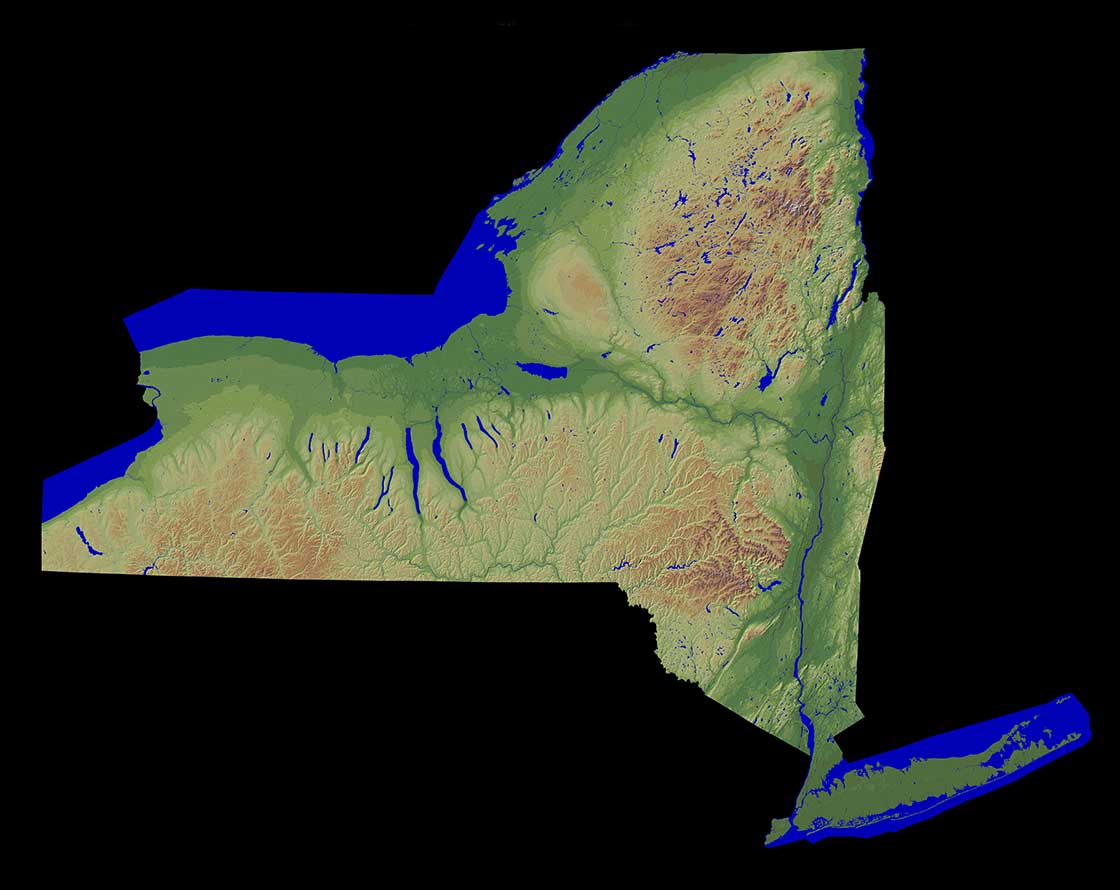
Below is the same map, with a red line through the Mohawk Valley, a black line indicating the Hudson River, and a yellow spot marking Albany.
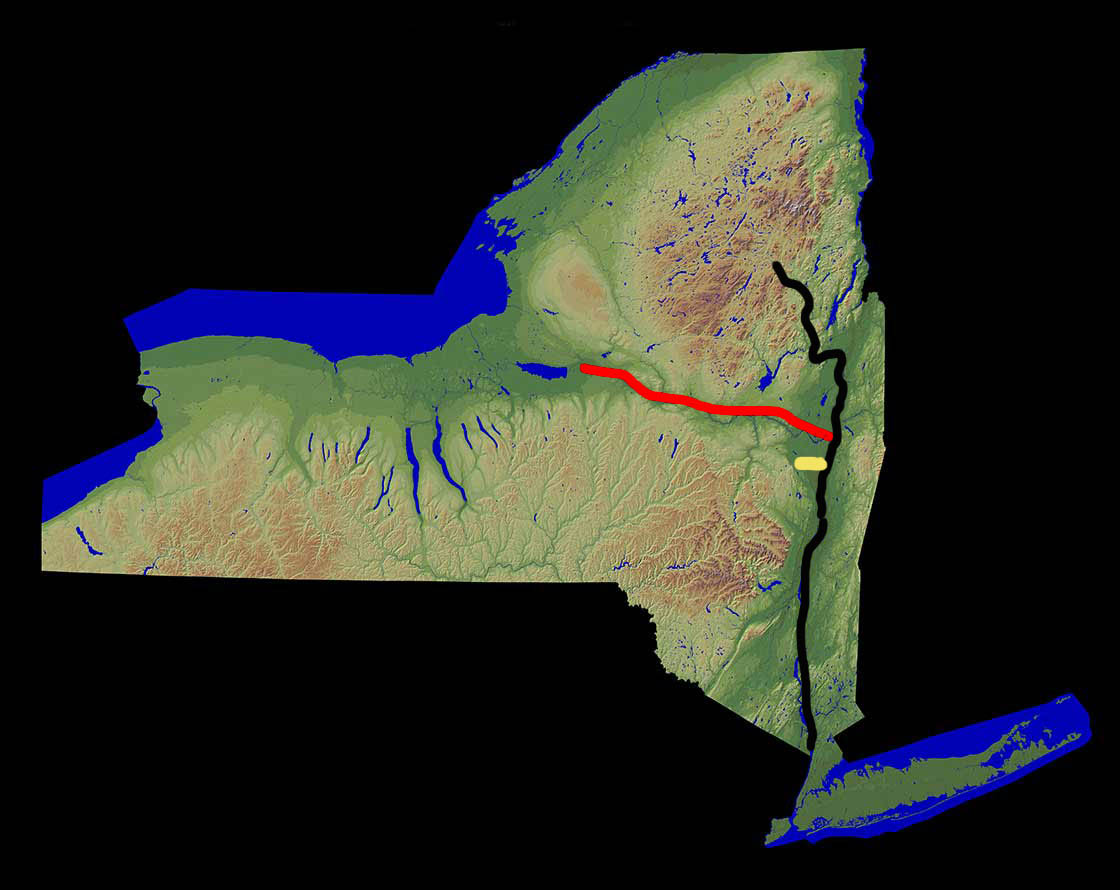
Westward migration was obstructed by the Appalachian Mountain Range, which extends (under various names) from Georgia to Canada. The Mohawk Valley is one of the few passes through these mountains, so it was a popular route for people going west. The mural below, “Gateway to the West,” is at the Post Office in Baldwinsville, New York. A frontiersman in a fur cap is telling migrants about the western lands. The migrants have an ax and a plow; they’re ready to clear land and plant crops. A canal boat can be seen on the left. Such murals can be found in many Post Offices; they were funded in the 1930s by FDR’s New Deal.

When the Hudson is about ten miles south of Lake George, it veers to the west, so it never reaches Lake George — there’s a gap in the “northern highway.” For Native Americans and early Europeans, this was The Great Carrying Place, a 10-mile portage from the northernmost point on the Hudson to the southern edge of Lake George.
Likewise, the Mohawk River doesn’t reach the Great Lakes, so there’s a portage at the westernmost point of the Mohawk. So New York State has two major rivers, and two major portages. The Erie Canal connected the Hudson to the Great Lakes, and the Champlain Canal connected the Hudson to Lake Champlain. Once these canals were built (around 1825), it was no longer necessary to portage, you could stay in your boat, and leave your goods in your boat.
No sooner were the canals completed than planning began for railroads; the Mohawk and Hudson Railroad was chartered in 1826, just one year after the Erie Canal was finished. So if you take an aerial view of the Mohawk Valley, you see river, canal, railroad, highway, bikepath, etc.1

Aerial View of Mohawk Valley
I mentioned above that the Hudson veers to the west before reaching Lake George. A fort called Fort Edward was built near the northernmost navigable point on the Hudson, where the portage would begin (for people travelling north).2 Fort Edward was built near Rogers Island, which is named after Robert Rogers, leader of Rogers’ Rangers. Rogers wrote a handbook on irregular warfare. Rogers Island has exhibits on Rogers’ Rangers; Rogers Island is to Army Rangers what Mecca is to Muslims, and Rogers’ handbook is the Koran.
Robert Rogers fought on the English side in the French & Indian War, then remained on the English side during the American Revolution, eventually making his way to England, and dying in England in 1795.3 In 1759, Rogers led a force that massacred Native Americans at St. Francis, near the St. Lawrence River.
There were numerous massacres carried out during the long conflict between the French (and their Indian allies) and the English. One such massacre was at Schenectady in 1690. Schenectady is on the Mohawk River, about 15 miles northwest of Albany. In 1690, Schenectady was protected by a stockade, but the French and Indians managed to slip inside and massacre about 60 people. One Dutch resident escaped and rode to Albany to sound the alarm. Schenectady has a Stockade Historic District.
I mentioned above that Fort Edward was built at the northernmost point on the Hudson, where the portage to Lake George would begin. Fort Stanwix was built at the westernmost point on the Mohawk River; Fort Stanwix guarded the portage, which was called the Oneida Carry.
Fort Stanwix was built by the British during the French & Indian War, and abandoned after that war. During the American Revolution, it was occupied by the colonists, and withstood a British siege. The colonial commander was Peter Gansevoort, maternal grandfather of Herman Melville. Melville named one of his sons “Stanwix” to perpetuate the family’s glory. Melville’s older brother, Gansevoort, had a fur business in Albany; Herman worked in this business for a time.4
The fighting around Fort Stanwix during the American Revolution was the subject of a popular novel called Drums Along the Mohawk (1936). The author of this novel, Walter Edmonds, also wrote a novel about the Erie Canal, Rome Haul.5 James Fenimore Cooper wrote about NewYork history in several novels, including The Last of the Mohicans, which is set during the French & Indian War. Washington Irving wrote about Dutch settlers along the Hudson in the stories “Rip van Winkle” and “The Legend of Sleepy Hollow.” Russell Shorto wrote about the Dutch era in a historical work called The Island at the Center of the World: The Epic Story of Dutch Manhattan. William Kennedy wrote a series of novels about Albany, and a non-fiction work about Albany.
Below is a mural depicting “Rip van Winkle.” The mural is at the Post Office in Troy, New York.

“a company of odd-looking personages playing at ninepins.... Nothing interrupted the stillness of the scene but the noise of the balls, which, whenever they were rolled, echoed along the mountains like rumbling peals of thunder.... His companion now emptied the contents of the keg into large flagons, and made signs to him to wait upon the company.” (from “Rip van Winkle”)
Below is a picture of Helderberg Escarpment in Thacher State Park, about ten miles west of Albany. This escarpment is part of the spine or ridge-line of the Appalachian Range, a ridge-line that stretches south to Georgia.
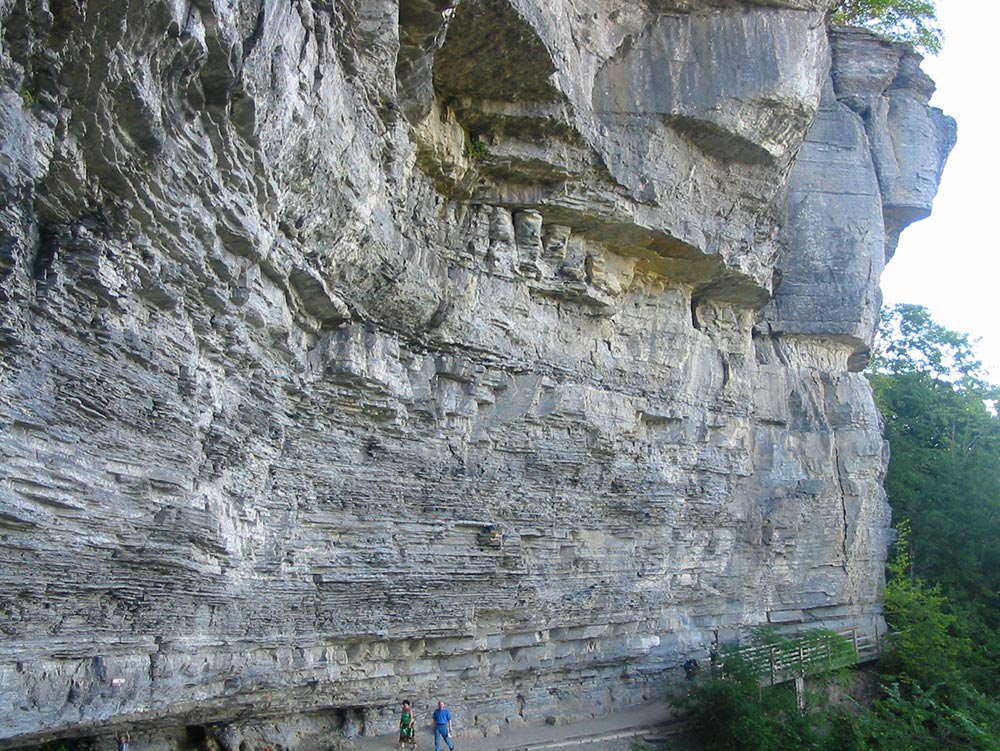
I visited Mabee House, which is on the Mohawk River in Rotterdam, about 20 miles west of Albany. Built by a Dutch family in 1705, Mabee House claims to be the oldest house in the Mohawk Valley. Below is a picture of the Dutch-style fireplace in Mabee House. Notice that the fireplace is open on three sides. Since it has no supporting posts/jambs, it’s called a “jamb-less fireplace.”
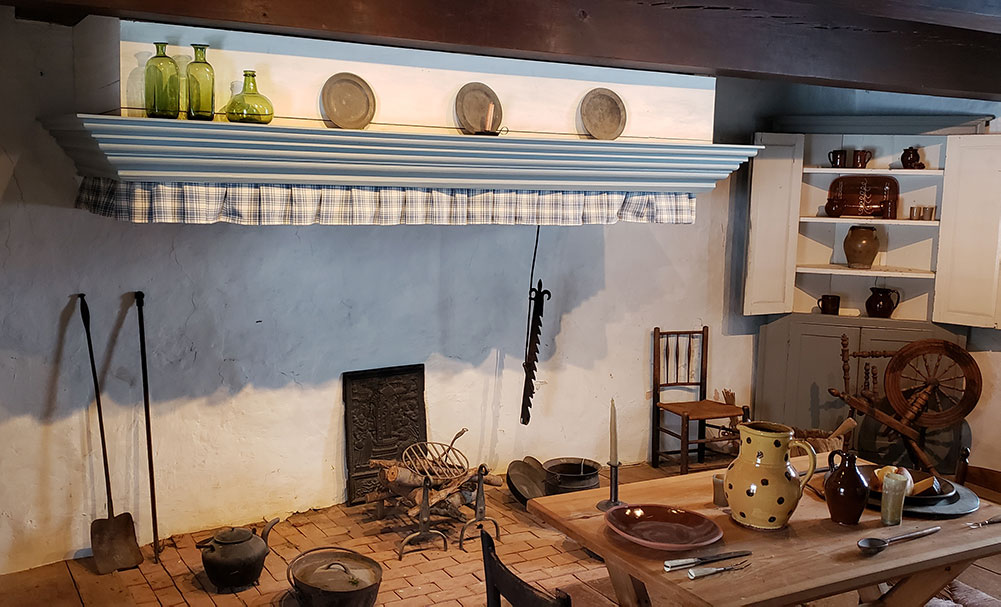
The guide at Mabee House was young and enthusiastic. He said that on early maps of New York, almost all towns were along the Hudson and Mohawk rivers; much of the state was uninhabited. It should be noted, however, that there’s a third river in New York that had early settlements: the Schoharie, which flows north into the Mohawk, and meets the Mohawk about 30 miles northwest of Albany. Near the Schoharie is a mountain called Vroman’s Nose, which is popular with hikers.6

Schoharie Valley from Vroman’s Nose
If you drive south along Schoharie Creek, toward Vroman’s Nose, you’ll be near the Old Stone Fort in the Town of Schoharie. The fort was built in 1772 as a church, then enclosed with a stockade. It’s now part of a complex of historic buildings, including a one-room school-house and a Dutch barn. A short walk north from the fort will bring you to a covered bridge.
The fort’s website says that it was “built as a High Dutch (German) Reformed church in 1772. It was the third building erected by the congregation of the Palatine German settlement of Fuchs Dorf (Fox Town).” Around 1700, Palatine Germans were driven from their homes by the soldiers of Louis XIV, King of France, and many settled in the Mohawk and Schoharie valleys.
When I visited the Old Stone Fort, I saw the hole in the rear of the fort/church that was made by a British cannonball in 1780. The British, accompanied by their Tory and Indian allies, stormed through the Mohawk and Schoharie Valleys with fire and sword on October 17, 1780, just after the harvest had been brought in. George Washington had been counting on the Valleys to provide grain to his troops.
During the French and Indian War, the Mohawk Valley was raided by the French and their Indian allies. I mentioned above that the Mohawk Valley was a “western highway,” a route for migrants going west. It was also a highway for invaders from Canada — first French, then British. These invaders could follow the St. Lawrence River from Montreal, then pass through Lake Ontario to Oswego, then enter the Mohawk Valley. Invading forces often struck the Palatines first, since they had settled in peripheral, exposed areas, such as German Flatts.
The Erie Canal Bikepath is popular with bikers; it stretches from Albany to Buffalo, a distance of about 350 miles. The best sections are said to be the easternmost 100 miles, and the westernmost 100 miles (you may need to ride on roads for part of the 150-mile central section). Below is a map of towpaths, locks, bikeways, etc.

Cohoes Falls, Mohawk River
One of the largest falls east of the Rockies
Almost 100 feet high
Below is a section of the bikeway.
Below is a section of the Albany County Rail Trail, a 5-mile section (10 miles round-trip). This route leaves the Rail Trail, and visits Delmar Five Corners and the Bethlehem Library. The Rail Trail starts in southeast Albany, and goes 9 miles west to Voorheesville.
I mentioned above that the English wrested control of New York from the Dutch in 1664. But Dutch residents remained, and mingled easily with the English. Dutch families like Rensselaer, Schuyler, and Vanderbilt were prominent in NewYork history, and three U.S. Presidents came from NewYorkDutch families: Martin Van Buren, Teddy Roosevelt, and Franklin Roosevelt. New York was the focus of Dutch settlement. “What about the ‘Pennsylvania Dutch’?” The Pennsylvania Dutch were actually German (Deutsch). “Pennsylvania Dutch” is a corruption of “Pennsylvania Deutsch.”
Below is “The Egg,” a performing-arts center in downtown Albany. It’s part of the Empire State Plaza, which was built around 1965. The Plaza was created by Governor Nelson Rockefeller, who was fond of modern art. Forty blocks of old Albany were levelled to make the Plaza.

If you like art museums, there’s one to the north of Albany (The Hyde Collection), one to the west (Arkell), one to the south (Olana), and one to the east (Clark). If you drive to the Clark Museum on Route 2, you climb up and over the Taconic Ridge, a ridge that separates New York from Massachusetts. When you reach the highest point, there’s a small parking area south of the road, and a short trail north of the road. The trail leads to a lookout from which you can see westward. The Clark Museum is in Williamstown, a charming town and the home of Williams College. From the Clark, you can climb a hill that affords a view of the surrounding area.
Williamstown was settled as a buffer against the HudsonValley Dutch, as Ipswich was a buffer against the French in Canada.
Bikers might enjoy the nearby Ashuwillticook Rail Trail, a 13-mile trail (26 miles round-trip) that offers views of the Hoosic River and the Cheshire Reservoir. If you ride north, the path descends 250 feet, though it will seem flat. You’ll see the Greylock Range to the west, the Hoosac Range to the east (“Ashuwillticook” means “pleasant river between the hills”). There’s a view of Mt. Greylock from the town of Adams (Adams is the northern terminus of the trail). Greylock can often be identified by the tower at its summit. Greylock is the highest peak in Massachusetts; it is said that, from Greylock’s summit, you can see five states. A paved road leads to the summit, and the Appalachian Trail also leads to the summit.
The Hoosic River originates around Pittsfield, and flows north and west to the Hudson. The Housatonic River also originates around Pittsfield, and flows south to Long Island Sound. So Pittsfield is on the edge of two watersheds. The North Branch of the Hoosic River joins the Hoosic in North Adams, while the Little Hoosic River joins the Hoosic in Petersburgh, New York.
Olana is a house/museum about 45 miles south of Albany. It sits on a hilltop, and has great views of the Hudson and the Catskills. It was built by the painter Frederic Church, whose landscapes commanded high prices around 1860. Church traveled to Ecuador in the 1850s; one of his best-known paintings is The Heart of the Andes. In the 1860s, he travelled to Europe and the Middle East; one result of this trip was a painting of Petra. He began building Olana in 1870. Olana is named after a Persian fortress, and its style is Persian/Moorish.
Church had studied with the painter Thomas Cole, who was based in the town of Catskill, just across the river from Olana. You can walk from Olana to the Cole house, crossing the Hudson on the Rip van Winkle Bridge; the 3-mile walking route (6 miles round-trip) is called Skywalk.

View from Olana
About 20 miles south of Albany is the charming and historic town of Kinderhook, birthplace of Martin van Buren. You can tour the stately house, Lindenwald, where van Buren spent the last twenty years of his life. One mile north of Lindenwald is the humble Van Alen House, which was built in 1737. A trail called the Dutch Farming Heritage Trail leads from Lindenwald to the Van Alen House. A shorter trail takes you around the grounds of Lindenwald.
Since Lindenwald is owned by the National Park Service, the tour is free. My guide was first-rate. He said that, a few years ago, an elderly woman who had once lived at Lindenwald took his tour. She told him that a bed in the house was the very bed in which van Buren had died. The guide asked her, “How do you know that?” She said, “Because the bed broke and fell to the ground on July 24, the same day that van Buren died.”
Below is an ogee arch at Lindenwald, flanked by portraits of Jefferson and Jackson. Van Buren was initially a member of Jefferson’s party, which was known as the Republicans, or the Democratic-Republicans; this party was opposed to the Federalists. Later, van Buren was a Democrat, and served as Andrew Jackson’s Vice President. The Democrats were opposed to the Whigs.
In 1849, Henry Clay, a leading Whig, spent three nights at Lindenwald, accompanied by his slave, Levi. After Clay left Lindenwald, abolitionists gave Levi $300 to run away, and thereby embarrass Clay. But after running away, Levi had a change of heart, returned the money, and came back to Clay.
This ogee arch must have been added by Richard Upjohn, who modified Lindenwald around 1840. The ogee arch is a Gothic feature, found in Venetian palazzos. Upjohn added various Gothic and Italianate features to Lindenwald. When the house was originally built in 1797, the Gothic style wasn’t yet popular, Ruskin hadn’t yet written paeans to Venetian Gothic.

Van Buren enjoyed country life, and managed a large farm. One day, he went fishing with a neighborhood boy, using a new rod he’d bought in New York City. They encountered a large turtle, and poked it with the rod. The turtle clamped its jaws on the end of the rod, and wouldn’t let go. Van Buren and the boy followed the turtle as it ambled along, dragging the rod after it. They tried without success to induce the turtle to abandon his prize. When their patience was wearing thin, the boy said, “I have an idea. I can cut the head off the turtle.” But van Buren didn’t approve. Finally they decided to cut the end off the rod. Then the turtle walked away with the end of the rod in its mouth. Van Buren said it looked like a drunken sailor with a cigar in his mouth.
In downtown Kinderhook is a historic house that some people call The Burgoyne House. British General Burgoyne stayed here in 1777, after he was taken prisoner at Saratoga.
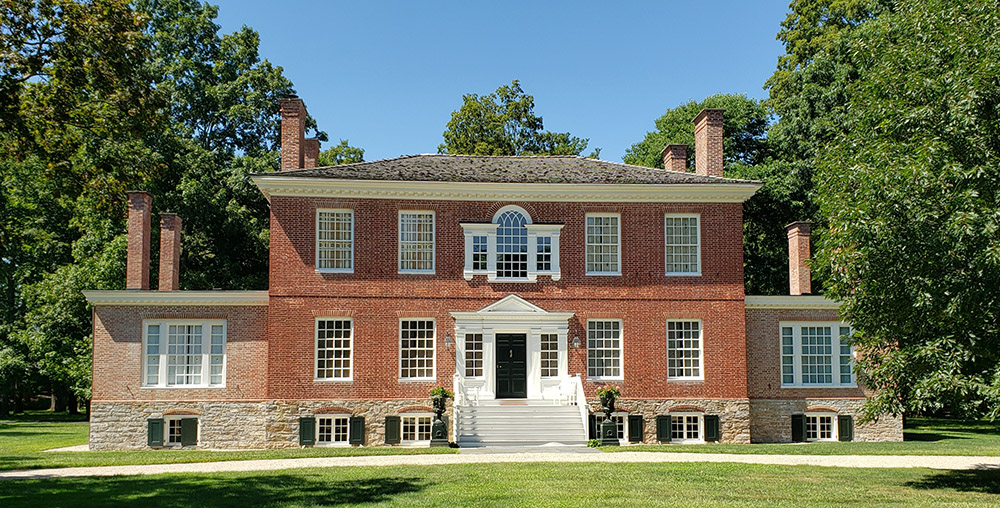
The Burgoyne House, built 1774
About 50 miles southeast of Albany is Bash Bish Falls. The falls themselves are in Massachusetts, but many people hike to the falls on a short trail that starts in New York. The trail goes along a deep gorge; at the bottom of the gorge is Bash Bish Brook. A slightly longer trail begins at Copake Iron Works, which has various displays about 19th-century iron-making. Slightly east of Copake Iron Works is the Harlem Valley Rail Trail, which may eventually extend from Wassaic in the south to Chatham in the north, a total of 46 miles.6B
About 30 miles north of Albany, on a bluff overlooking the Hudson, is the Saratoga battlefield/park. It was here that the colonists stopped Burgoyne, who was trying to march from Canada to Albany. Burgoyne’s entire army surrendered, prompting France to join the war on the American side. If you want to explore the park by car or bike, there’s a paved road, 11 miles long. You can also follow a 5-mile walking trail.
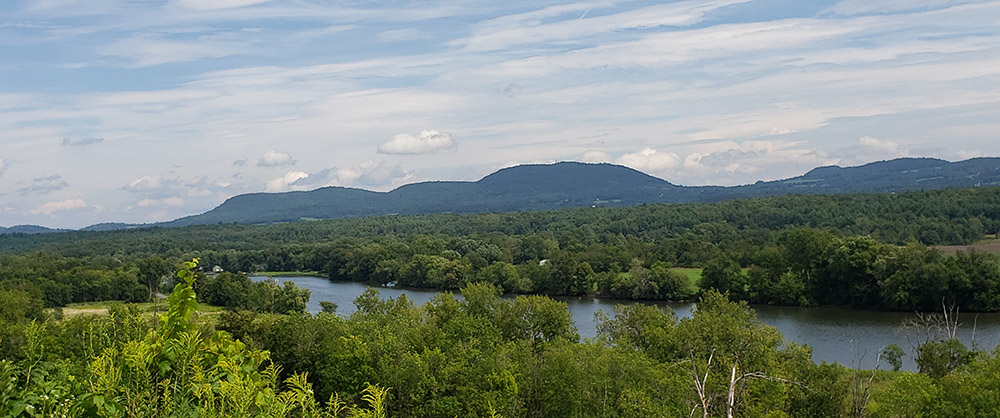
Hudson River from Saratoga battlefield
The Saratoga battlefield is near the town of Saratoga Springs, which was a popular spa town, and then became known for horse-racing. Saratoga Springs has some interesting architecture and some historic hotels.
About ten miles north of Saratoga Springs is Grant Cottage, where Ulysses Grant spent his last six weeks, and completed his memoirs (Grant Cottage is in the town of Wilton NY). The cottage offers tours and good views.
About twenty miles north of Grant Cottage is Lake George. When Jefferson visited Lake George in 1791, he said, “Lake George is without comparison, the most beautiful water I ever saw; formed by a contour of mountains into a basin... finely interspersed with islands, its water limpid as crystal.” The southern edge of Lake George is easy to access — close to a major highway (Route 87); some of the other shores are difficult to reach without a boat.
Fort William Henry is at the southern edge of Lake George, Fort Ticonderoga is just north of Lake George. Both forts offer tours. If you want to see authentic ruins of an old fort, visit Fort George, which is near Fort George Road, just southeast of Fort William Henry. Fifteen miles north of Fort Ticonderoga is Crown Point, which also has an old fort; Crown Point is on the western shore of Lake Champlain.
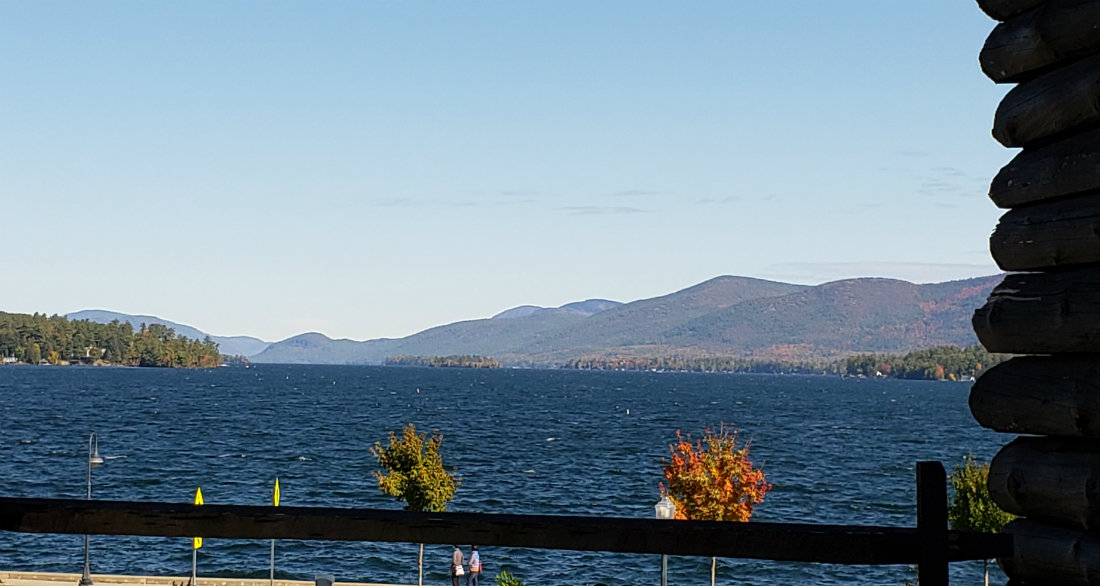
Lake George from Fort William Henry
Near the intersection of Fort George Road and Beach Road is the northern terminus of the Warren County Bikeway, which goes south to Glens Falls, a distance of ten miles. Most bikepaths are flat, but this bikepath has several hills. It also has several signs about local history, especially about the Battle of Lake George, which took place in 1755, during the French & Indian War. The English won this battle, and built Fort William Henry to consolidate their gains. The English commander, William Johnson, named the lake “Lake George” after George II, the reigning king (the French had called it Lac du Saint-Sacrement, Lake of the Holy Sacrament). Johnson named his new fort “William Henry” after British princes.
Prospect Mountain is near the southern edge of Lake George. You can drive or hike to the summit, and get a good view of the lake, and the whole region.
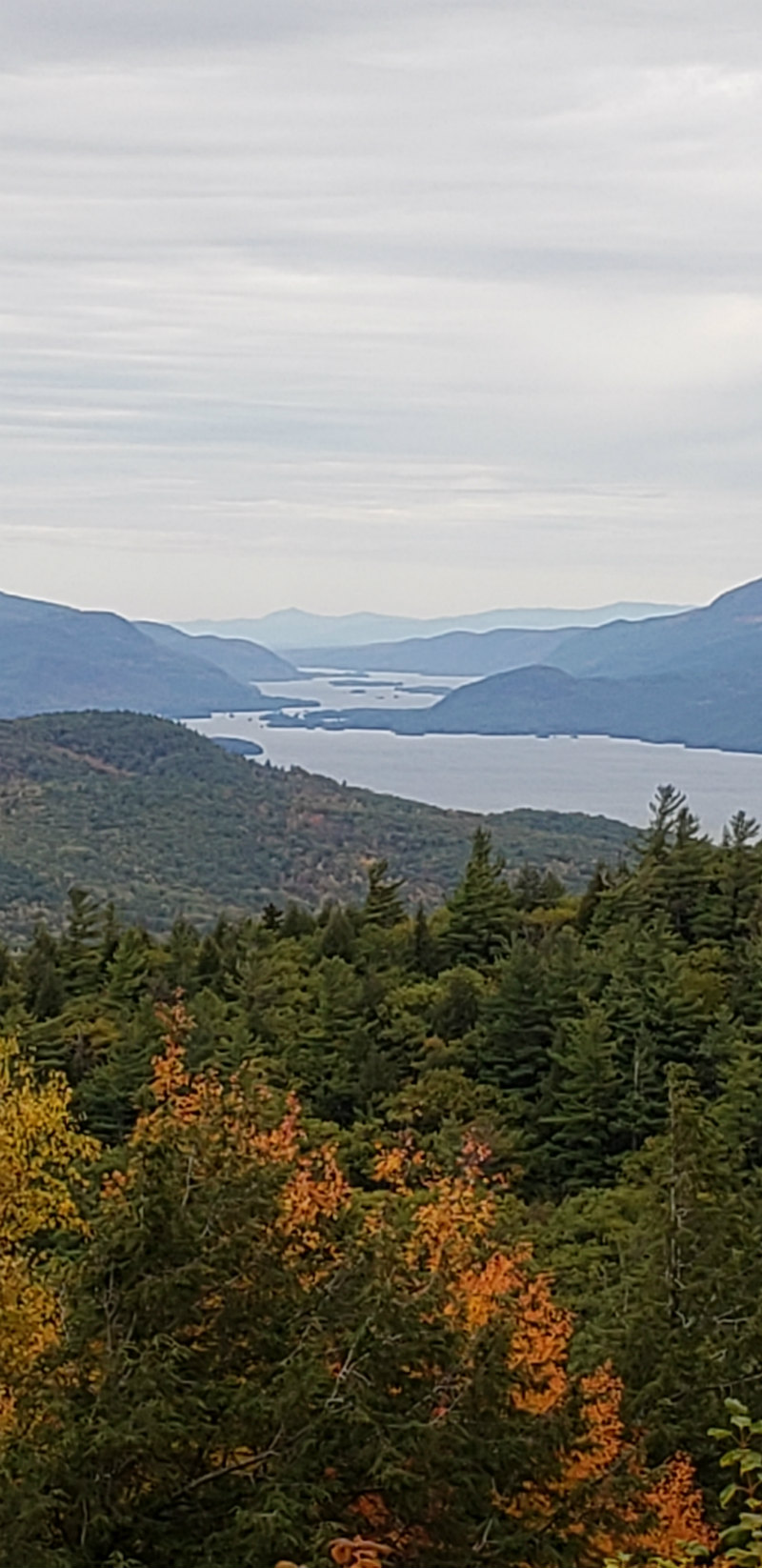
Lake George from Prospect Mountain
Shelving Rock Mountain is on the east shore of Lake George, about ten miles north of Fort William Henry (Lake George is 32 miles long). Driving to Shelving Rock isn’t easy; the route is rather circuitous, and you’ll be on dirt roads much of the time. Below is a 5-mile hike to Shelving Rock Mountain and Shelving Rock Falls. The walk to the falls is short and easy, the mountain is longer but not difficult. From the summit, you can see the south end of the lake, but the view to the west and north is blocked by trees. Have the rangers decided that trees are more important than views? If you want wider views, hike Black Mountain (east side of Lake George) or Fifth Peak (west side).
Below is a picture of Rensselaerville Falls, which is about 20 miles southwest of Albany.

Below is the Grafton Peace Pagoda in Grafton, New York, about 20 miles northeast of Albany. Sometimes called a “stupa,” the pagoda can’t be entered, it has no interior. Buddhists often walk around the pagoda; one might call it walking meditation, or walking worship. The outside of the pagoda is decorated with scenes from the life of the Buddha.
The pagoda is part of a group of buildings managed by a resident nun, Jun Yasuda. Jun is welcoming, and may invite you into the hall for drumming, chanting, etc. The architecture is charming. Some visitors bring small gifts, such as a bag of rice. And Jun may give you a small gift (she gave me an Asian pear).
There are about 80 peace pagodas scattered throughout the world, built by a Japanese Buddhist order. Jun has walked across the U.S. five times, beating her drum and praying for peace.

I read an essay on War and Peace by a Northwestern professor named Gary Saul Morson. Morson specializes in Russian literature (in an earlier issue, I mentioned his essay on Dostoyevsky’s Idiot).
As we saw in the last issue, the 19th century had confidence in rational thinking and the scientific method. Several intellectuals thought that this confidence was excessive. In his novel Hard Times, Dickens satirized 19th-century economists who tried to reduce life to economic calculations. One of the characters in Hard Times, Mr. Gradgrind, names his children “Adam Smith” and “Malthus.”
One of Dickens’ contemporaries, John Ruskin, was also critical of economics. Dickens and Ruskin saw the suffering that resulted from capitalism and industry, but they had no faith in socialist schemes, no faith in attempts to organize society on rational lines. The attitude of Dickens and Ruskin might be described as conservative/Tory/aristocratic. They often agreed with the arch-conservative Carlyle, who was a few years older than they were. Carlyle was the first to describe economics as a “dismal science.”7
Gary Saul Morson describes Tolstoy as one of the 19th-century intellectuals who was wary of reason and science and socialist schemes. Rational thinking and socialist schemes were popular in Russia: “Even more than their Western European counterparts,” Morson writes, “Russians were obsessed with establishing a hard social science, as certain as physics.” Many Russians put their faith in Marxism, which its adherents described as “scientific socialism.”
Tolstoy swam against this current, against the rational-scientific current. Morson says, “Tolstoy was known as a nyetovshchik — someone who says nyet, or no, to all prevailing opinion.”8 Tolstoy was scornful of the attempt to rationalize life: “If we concede that human life can be governed by reason,” Tolstoy wrote, “then the possibility of life is destroyed.”
In War and Peace, Tolstoy mocks the attempt to make war into a science.
| As the novel begins, its main hero, Prince Andrei, believes in a science of warfare, which German generals and theoreticians claim to have elaborated. Tolstoy allows this purported social science to stand for all others, existing or to come. At the council of war before the Battle of Austerlitz (1805), the Russians and their Austrian allies plan their campaign according to their supposed science and are certain that “every contingency has been foreseen.” They suffer a disastrous defeat.9 |
The best general in War and Peace, Kutuzov, has no use for military science, and dozes off during the council of war. Kutuzov lives by feeling and instinct, and thus he reminds one of Dickens-characters like Sleary, Guppy, and Glubb. In both Tolstoy and Dickens, the “feeling characters” are portrayed in a more positive light than the “reason characters.”
Tolstoy describes how the young officer Nikolai Rostov leads a successful charge because he acts “instinctively,” without reflection or hesitation.
Dostoyevsky’s attitude toward reason was much the same as Tolstoy’s. But instead of satirizing the science of war (as Tolstoy did), or the science of economics (as Dickens did), Dostoyevsky criticized Buckle’s theory of social progress, social organization. Dostoyevsky insisted that people don’t act from rational motives, and don’t pursue their self-interest. People have negative impulses, sadistic impulses; the protagonist of Notes From Underground says that he “felt intense enjoyment when I succeeded in making anybody unhappy.” Dostoyevsky was skeptical of social progress because he understood man’s negative impulses. Russia’s experiment with Marxism, with social re-organization, validated Dostoyevsky’s views.
Dostoyevsky eventually took refuge in the Orthodox Church, but Tolstoy made his own religion. Though Tolstoy was critical of reason, he couldn’t accept the irrational elements in Christianity. When Tolstoy was a young officer in Crimea, he had a vision of a Christianity purged of mythology. In his later years, he constructed his own brand of Christianity, which was in keeping with his youthful vision.
We can’t call someone “an admirer of reason,” or “a critic of reason” without saying what yardstick we’re using, what our standard of comparison is. These are relative terms, like short and tall. Gulliver was tall in Lilliput, but short in Brobdingnag. Tolstoy was a critic of reason compared to 19th-century rationalists, but he was rational compared to others. For example, Tolstoy was rational compared to Kierkegaard, who embraced Christianity in toto. And Tolstoy was rational compared to Jung, who respected the mythical elements in Christianity. And Tolstoy was rational compared to Shakespeare, who was receptive to prophecy, synchronicity, and other aspects of the occult; Tolstoy couldn’t grasp Shakespeare’s holistic/Hermetic worldview, and insisted that Shakespeare was a second-rate writer. Morson depicts Tolstoy as a critic of reason, but this is only half the story.
Morson doesn’t discuss Tolstoy’s interest in the philosophy of history, in the laws of history. In War and Peace, Tolstoy says that historians and philosophers should seek historical laws, should seek the driving forces of history (as I’ve done with my theory of the life- and death-instincts of societies). Tolstoy realizes that it’s futile to seek specific causes — the more we seek, the more causes we find, and every cause has more causes behind it. But it’s not futile to seek general laws, driving forces. “Instead of seeking causes,” Tolstoy wrote, “history sets before itself the task of seeking laws.... To discover and define those laws is the problem of history.”
What sort of laws does Tolstoy have in mind? He says that “the number of births or of crimes is subject to mathematical laws,” and “certain relations of population to soil produce migrations of peoples.” He says that “a certain mode of government was established... in consequence of such and such geographic, ethnographic, or economic conditions.” Tolstoy doesn’t mention psychological forces, such as the forces I’ve emphasized, but I think he’d be receptive to my approach.
When Tolstoy started writing, he intended to write a novel about the Decembrist uprising of 1825. But when he looked for the causes of this uprising, each cause had other causes behind it, so he was led back to Napoleon’s invasion of Russia in 1812. By seeking the causes of the Decembrist uprising, he learned a deep truth about history in general: every event has countless causes, and each of these causes has countless causes, so the search for causes is futile. Hence Tolstoy called on historians to abandon the search for causes, and seek historical laws.
Morson doesn’t grasp the difference between laws and causes, so he misunderstands Tolstoy’s approach to history, he misunderstands an important part of War and Peace. Morson’s essay on War and Peace will only satisfy people who haven’t read the book. Morson’s attitude seems to be, “No one understands the philosophy of history, no one is interested in it, so I can ignore that aspect of War and Peace, I can depict Tolstoy as a champion of chance. Everybody understands chance, everybody will understand my essay, agree with it, and like it.”
Morson’s editor at the New Criterion, Roger Kimball, evidently wanted an essay that was readable, and didn’t care whether it was true. Kimball has a penchant for skating along the surface; in an earlier issue, I quoted Kimball’s remark about “the poor souls who believe that Francis Bacon or the Earl of Oxford wrote the plays commonly attributed to Shakespeare.” If Kimball doesn’t care about the truth regarding Shakespeare, why would he care about the truth regarding Tolstoy? Why care about truth at all? If we can achieve readability and plausibility and respectability, why bother about truth? Who cares?
Henry James doubtless spoke for many readers when he said that he liked the sledding scene in War and Peace, but he didn’t like all the theorizing about history. Tolstoy must have known that the great majority of readers didn’t enjoy his theorizing, they wanted a novel. But Tolstoy chose truth over readability. Tolstoy cared about truth.
Tolstoy called on historians to seek laws, driving forces, rather than being satisfied with free will and chance. I believe we should seek the driving forces of history in human nature, not just in soil, climate, economic conditions, etc. My theory of history draws on psychology — more specifically, it draws on Freud’s theory of life- and death-instincts. Historical laws allow us to better understand the past, to better understand human nature, and to make general predictions about the future. Historical laws don’t permit precise predictions, and don’t eliminate free will. Tolstoy had a deep understanding of the importance of historical laws, and the possibility of a philosophy of history.
Morson denies the possibility of historical laws, and he says that Tolstoy denies the possibility of historical laws. According to Morson, we live in “a world of contingency.... No one can foresee whom a particular bullet will kill, and yet how soldiers react to such contingencies makes all the difference.” No laws shape events, and no predictions are possible. Morson quotes Tolstoy:
| “What are we facing tomorrow?” Andrei asks his friend Pierre before the battle of Borodino. “A hundred million chances which will be decided on the instant by whether we run or they run, whether this man or that man is killed.” |
Morson and Tolstoy both overlook Fate. But Napoleon understood the importance of Fate, and so did Shakespeare. This isn’t “a world of contingency,” as Morson says. In Shakespeare’s Julius Caesar, the soothsayer tells Caesar, ‘Beware the Ides of March, you will be killed on the Ides of March, no contingency can save you, it is your Fate to die on the Ides of March.’
When Napoleon was young, he felt that it was his Fate to conquer, and therefore he felt that he was immune to assassination:
| During the period of conspiracies [Napoleon said] they used to try and scare me with the story that Georges was dogging my footsteps in order to assassinate me. The utmost he could do however was to murder my aide-de-camp. It was impossible to murder me at the time. Had I already fulfilled my destiny? I feel as if I am being driven towards an unknown goal. As soon as it is attained and there will no longer be any use for me, an atom will be sufficient to annihilate me; but until then, all human efforts whether in Paris or in the army will be powerless to prevail against me. |
The young Napoleon was immune to assassination. Fate was on his side. No contingency could bring about his death; contingency is the slave of Fate. At Waterloo, on the other hand, Napoleon felt that Fate was against him, no contingency could prevent his defeat. “I beheld the decisive hour gradually approach. The star grew dim; I felt the reins slip from my hands, and yet I could do nothing.”
Fate plays an important role in human events, but that doesn’t mean that contingency has no role, and free will has no role. The human mind can’t grasp how these three factors (fate, chance, and free will) co-exist and inter-mingle. But to say that this is “a world of contingency” (as Morson does) is an over-simplification. And when Morson says that Tolstoy believed this is “a world of contingency,” he over-simplifies Tolstoy’s view.
And it’s a weakness in Tolstoy, not a strength, if he emphasizes contingency and overlooks Fate. Morson praises Tolstoy for emphasizing “tiny bits” and “infinitesimally small changes,” but perhaps Tolstoy overlooks the broad brush-strokes of Fate, perhaps he overlooks what his nemesis, Shakespeare, emphasized. Perhaps Shakespeare was a greater writer than Tolstoy because he depicted Fate with broad strokes, and wasn’t preoccupied with “tiny bits.”
Physicists finally had to admit that light was both a particle and a wave, though they couldn’t explain how that was possible. Likewise, we may need to admit that human events are controlled by Fate, contingency, and free will, though we can’t explain how these three factors can co-exist.10
History is complicated, mysterious. Tolstoy struggled to understand history, and few writers have ever come closer to grasping history. He saw the importance of historical laws, of underlying forces. He saw the possibility of a philosophy of history that would explain these underlying forces. In the end, perhaps he fell short, perhaps he failed to grasp history, perhaps he over-emphasized chance. But if he failed, what a bold failure! What an admirable failure! For such a failure, surely one deserves immortality.
I saw the acclaimed movie Roma, and was much impressed. It’s called Roma because it’s set in a MexicoCity neighborhood called “Colonia Roma.” It draws on the childhood experiences of the writer/director, Alfonso Cuaron, and it takes place around 1970. It portrays Mexican society — both the “haves” and the “have nots.” It’s unusually simple, truthful, tasteful. It doesn’t jar the viewer with graphic violence, as many contemporary movies do.
© L. James Hammond 2019
feedback
visit Phlit home page
Become a patron via Patreon
make a donation via PayPal
| Footnotes | ||||
| 1. | One might suppose that the canal became obsolete as soon as the railroad was completed. But the canal remained in use, it was even enlarged and improved. The improved canal, known as the Barge Canal, was completed in 1918. back | |||
| 2. | I call it the “northernmost navigable point” because north of this point are falls and rapids that prevent navigation. back | |||
| 3. | In the 1930s, Kenneth Roberts wrote a popular novel about Robert Rogers. He called it Northwest Passage because, at the end of his life, Rogers tried to interest the English king in an expedition to find the Northwest Passage. back | |||
| 4. | You can visit the Melville House in Troy, which is a few miles north of Albany. There’s another Melville House in Pittsfield, Massachusetts. back | |||
| 5. | Drums Along the Mohawk was made into a movie, as was Northwest Passage. Rome Haul was made into a movie called The Farmer Takes A Wife.
Harold Frederic wrote In The Valley (1890), a novel about the Mohawk Valley during the American Revolution. Click here for an essay by Frederic on the same subject. back | |||
| 6. | The Schoharie is known as “Schoharie Creek,” though it would seem more fitting to call it a river. back | |||
| 6B. | Writing about 1840, geologist Edward Hitchcock said that Bash Bish Falls is “the most remarkable and interesting gorge and cascade in Massachusetts.” Hitchcock spells it “Bashapish or Bash-Pish.” He says,
Hitchcock notes that it isn’t an easy place to reach: “It is an enterprise of no small magnitude to get to the spot; especially for ladies: none of whom but the most resolute and vigorous should attempt it.” Hitchcock recommends going to the top of the falls first. He reached the top by climbing what he calls Mt. Washington. He describes the view from Mt. Washington thus:
This view may not be possible today; Mt. Washington appears just east of BashBishFalls State Park, 1667 feet high, but no trails ascend it. After enjoying this view, Hitchcock made his way to the bottom of Bash Bish Falls:
| |||
| 7. | In an earlier issue, I quoted George Bernard Shaw, who said that Dickens “adopts the idealized Toryism of Carlyle and Ruskin, in which the aristocracy are the masters and superiors of the people, and also the servants of the people and of God.” Some might object that Dickens sympathizes with the working-class, and takes a dim view of aristocrats. Perhaps Shaw is discussing policies, not sympathies. back | |||
| 8. | Tolstoy said nyet to pan-Slav feeling, which occasionally swept through Russia: “[Sergey] saw that the Slavic question had become one of those fashionable distractions which succeed one another in providing society with an object and an occupation. He saw, too, that a great many people were taking up the subject from motives of self-interest and self-advertisement. He recognized that the newspapers published a great deal that was superfluous and exaggerated, with the sole aim of attracting attention and talking one another down. He saw that in this general movement those who thrust themselves most forward and shouted the loudest were men who had failed and were smarting under a sense of injury — generals without armies, ministers not in the ministry, journalists not on any paper, party leaders without followers.” (Anna Karenina, VIII, 1) Leading intellectuals often take issue with fashionable trends; as Kierkegaard put it, “Genius like a thunderstorm comes up against the wind.” back | |||
| 9. | Morson, essay in New Criterion. back | |||
| 10. | Whether light is a particle or a wave depends on the viewpoint of the observer. Likewise, whether an event is the result of necessity or freedom depends on our viewpoint. As Tolstoy said, “the more freedom we see in any action the less inevitability do we perceive, and the more inevitability the less freedom. The proportion of freedom to inevitability decreases and increases according to the point of view from which the action is regarded, but their relation is always one of inverse proportion.”
What stimulated Tolstoy’s interest in historical laws? Perhaps the same book that gave him his title, Proudhon’s War and Peace (La Guerre et la Paix). Proudhon’s book was published in 1861, War and Peace in 1869. The English writer Buckle published a philosophy of history in 1857. Buckle may have influenced both Proudhon and Tolstoy. One might call Buckle “the Spengler of his day.” Perhaps we shouldn’t try to trace these ideas to one individual, perhaps we should say that these ideas were “in the air,” they were the ideas of the time, hence they were popping up all over. back | |||